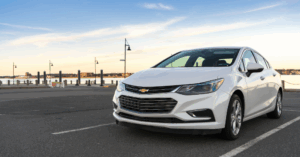
As the prices of used cars continue to increase, drivers on a budget are having a harder time finding late-model vehicles for less than $20,000. We’ll explore why it’s happening and what you can do about it.
Before the COVID-19 pandemic, over half of all used cars were three-year-old vehicles with price tags of $20k or less. Today, that vehicle type accounts for just 11% of all used cars, and most shoppers struggle to find late-model vehicles for less than $30,000.
A recent study from iSeeCars.com showed that the average list price for a three-year-old used car is up to $32,635, nearly $10,000 more than it was before the pandemic and its related supply chain issues hit.
High Demand Means Little Room to Negotiate
The demand for used cars is currently very high, which means there’s limited room for drivers to negotiate better prices, and dealers know they can charge a premium for late-model vehicles.
The average list price for a one- to five-year-old used car reached $31,257 in February, up 1% from the previous year, and $32,437 in June. That’s a 4.8% increase from last year’s prices.
For a few months, it seemed as if prices might finally be going down. While there’s no way to say what will happen next month, that trend has reversed itself for now.
What’s Missing From the Market?
Unsurprisingly, a large number of vehicles have moved out of the under-$20k range in recent years. Drivers used to be able to find a Chevy Equinox, Honda Civic, or Toyota Camry for less than $20,000, but that’s no longer the case.
The Kia Sportage, Nissan Rogue, and Toyota Corolla also join the ranks of more expensive models, and the difference is stark. In 2019, 97.6% of three-year-old Honda Civics were available to drivers with budgets of $20k. Now, that number has plummeted to just 5.7%.
The same trend is evident across all major brands and vehicle types. However, the average prices for passenger cars rose the most. They’re currently up by 48.7% from 2019, with an average list price of $29,343.
What Happened to Cause This Shift?
The most obvious contributor to increasing vehicle prices is inflation, which has risen since the pandemic. There are, however, also other contributing factors. Restricted new-vehicle production during the pandemic also played a role, as did the 2021 semiconductor shortage.
To complicate matters further, the new car shortage coincided with the time when many office workers were relocating to the suburbs, where personal transportation is often a necessity. The high cost of buying a new car means people are holding onto their vehicles for longer and even buying out leased ones.
The bottom line is that with fewer new cars manufactured from 2020 to 2022, more people were, and are, looking for older models. That increase in demand drove up prices, and they haven’t come back down since. That trend appears unlikely to change soon.
How to Find Affordable Used Cars
Are you looking for a used car under $20,000 and struggling to find one within your price range? It’s time to accept the new normal.
Today, $20k won’t buy a three-year-old car. It might still buy you an older vehicle, though, and most recently manufactured cars typically reach 200,000 to 250,000 miles easily.
Being open to a wider variety of automotive brands and vehicle models can also make it easier to find a used car in your price range, as can seeking out vehicles from further away. Some parts of the country haven’t seen the same spike in demand for used cars as others.
It’s not worth waiting for the price increases to subside. The chances are good that the days of the sub-$20k used car are over.
This post may contain affiliate links. Meaning a commission is given should you decide to make a purchase through these links, at no cost to you. All products shown are researched and tested to give an accurate review for you.








